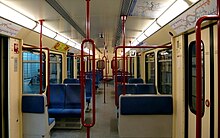VAG series DT2
| Nuremberg U-Bahn series DT2 |
|
|---|---|
|
DT2
|
|
| Numbering: | 529 / 530-551 / 552 |
| Number: | 12 double railcars |
| Manufacturer: | Adtranz , Siemens |
| Year of construction (s): | 1993 |
| Axis formula : | Bo'Bo '+ Bo'Bo' |
| Gauge : | 1435 mm ( standard gauge ) |
| Length over coupling: | 37,550 mm |
| Height: | 3,550 mm |
| Width: | 2,900 mm |
| Trunnion Distance: | 12,000 mm |
| Bogie axle base: | 2,100 mm |
| Empty mass: | 54.5 t |
| Top speed: | 80 km / h |
| Hourly output : | 8 × 90 kW = 720 kW |
| Driving wheel diameter: | 850 mm |
| Motor type: | Three-phase asynchronous BASI 5644 |
| Power system : | 750 V DC |
| Power transmission: | Lateral power rail coated from below |
| Brake: | pneumatic and electro-pneumatic brakes , spring-loaded , utility and resistance brakes |
| Seats: | 82 |
| Standing room: | 208 |
The VAG series DT2 is the next generation of vehicles from the DT1 series on the Nuremberg subway . Technically, it largely corresponds to the type B of the Munich subway .
development
At the beginning of the 1990s, several expansions followed in the Nuremberg subway network, mainly affecting subway line 2. Since the technology of the DT1 was no longer up to date, VAG decided to purchase a new series, the DT2.
The properties of the vehicles, a total of 12 double railcars, are based on the Munich B-type. The interior, d. H. the basic features of the seat layout, mechanics and window layout as well as the car body have been taken over from this. At the same time, VAG's new color design was presented with the DT2.
They were delivered in 1993 and 1994 and make a total of six circuits in the network. The car numbers of the vehicles are 529/530 to 551/552.
construction
The car body of the vehicle has been built using an integral aluminum construction. The arrangement of doors and windows as well as the passenger compartment division of the predecessor type DT1 were adopted. Only the compartments are designed with more standing space, so that only 82 instead of 98 seats are available. The main distinguishing features of the DT2 are the large, one-piece front screen, which on the DT1 is made up of three parts.
The bogies of the trains now also have motors that are transverse instead of lengthways to the direction of travel; two three-phase motors are attached to each bogie, which, however, also achieve a reduced performance compared to the previous model. The motors are one of the reasons why DT1 and DT2 cannot drive together in a group; only in an emergency, for example when towing, can the two types of train drive together mechanically.
Instead of the cam switchgear , there are now inverters and direct current controllers, which enables stepless control. Furthermore, the car on the way that have braking energy into the power grid feed back . The degree of recovery is 25 percent.
See also
- BVG series F - Comparable double multiple unit of the Berlin U-Bahn (F90, F92)
- BVG class 480 - comparable double multiple unit of the Berlin S-Bahn


